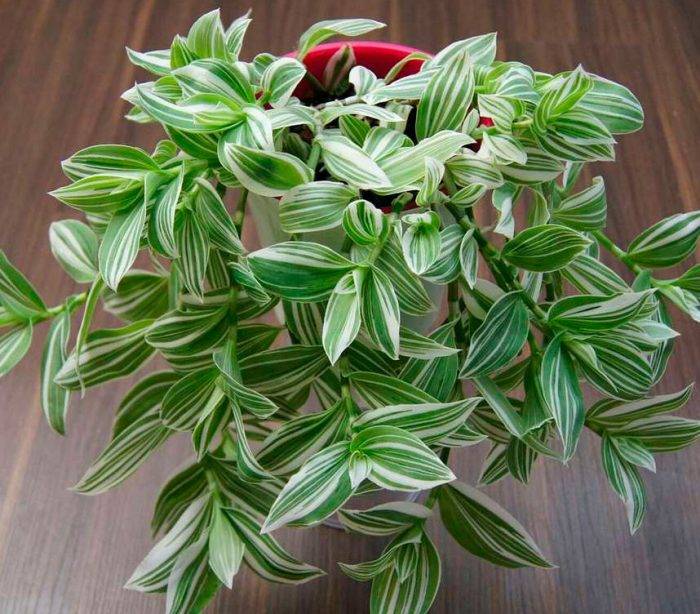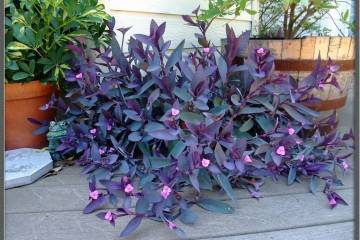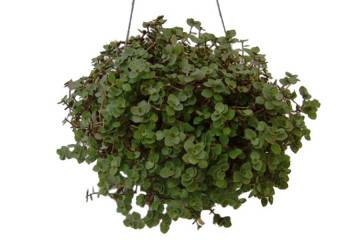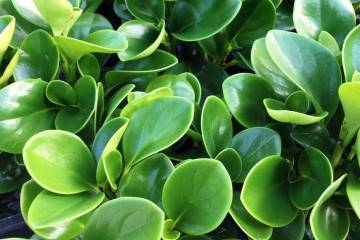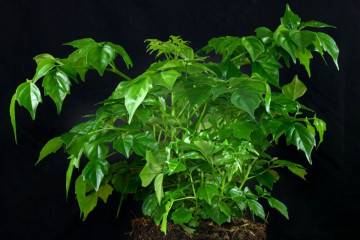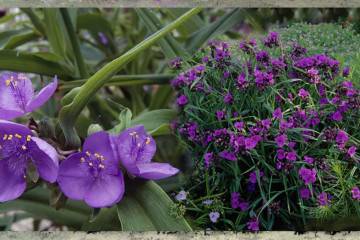Tradescantia - home care
Content:
Tradescantia is a perennial houseplant. Although it blooms, small buds are of no value. The attractiveness of Tradescantia is given by the leaves growing on long, straight stems. Depending on the variety, they differ in shape and shade. The flower is grown at home or in garden plots. Indoor tradescantia are the most popular.
Home care
Care is the basis of an attractive plant appearance. Tradescantia does not require much attention, it is recommended to purchase it even for novice florists. The flower cannot be called unpretentious, however, caring for a room Tradescantia is not burdensome, you need to remember a few simple recommendations.
Temperature and lighting
Tradescantia is comfortable at 22-26 degrees in summer. She needs coolness in winter. It is important that the thermometer is within 11-13 degrees. If the room is warmer, you need to provide additional light.
True, Tradescantia is striped, variegated, then it will lose its attractive pattern. The stripes on the leaves will become faded. Lack of home care for Tradescantia Violet, in particular a lack of light, will cause the stems to become thinner. The rich purple hue will disappear.
Riverine tradescantia (tradescantia fluminensis) will change in appearance under excessive light. Leaves, depending on the variety, have a different color. Some combine large green and pink stripes, while others have slightly noticeable white lines and dots on a bright green background.
In variegated tradescantia, the reverse side of the leaf is purple. And on the front side there are golden stripes. The pattern of the leaf plates will even out in the bright sun. They will become light and monochromatic.
Watering and humidity
Watering during the growing season and wintering is different:
- When the flower grows and develops, the soil must be moistened after the top layer dries;
- From late autumn to early spring, when the plant is transferred to a cooler place, watered when the soil in the pot is completely dry. If Tradescantia winters in a warm place, then moisten it when a quarter of the soil dries out.
Choosing a place for a flower
The place in the apartment is selected depending on the variety and pattern on the leaves. A bright color requires more light, otherwise it will become nondescript and faded. Tradescantia green monophonic feels good in the shade. But its stems will become longer, the shoots will stretch towards the sun. The same applies to the white-flowered tradescantia, it is quite comfortable without abundant lighting. Only the shoots of the plant will change.
Reproduction
Reproduction is usually carried out in two ways:
- By dividing the bush. It is carried out during the transplant. The flower is divided into two or three parts so that young shoots remain on each. New plants are planted in separate containers;
- By cuttings. Applicable at any time of the year. Cuttings are prepared with a length of about 5 centimeters. On the lower internode, one leaf is removed and placed in water.After rooting, they are planted in prepared nutrient soil.
Tips for florists
Tradescantia is not afraid of drafts, on the contrary, it prefers fresh air. Therefore, frequent airing will only benefit the flower. If the room is too dry, which is especially typical for the heating season, you can spray the leaves. In any case, this will not harm, because the indoor shrub reacts extremely painfully to drought.
Difficulties in growing Tradescantia
Improper care of Tradescantia leads to illness:
- Yellow leaves appear with insufficient watering.
- The plant does not bloom from an excess of fertilizers containing nitrogen.
- Large internodes are the result of a lack of light.
- The roots rot when excessive moisture, lack of drainage.
Diseases, pests and treatments
Compliance with the recommendations for flower care will help to avoid the appearance of insects that can harm the plant:
- aphids;
- scabbards;
- spider mite;
- thrips.
When a black film appears on the leaves, a sooty fungus infection has occurred. This happens after harmful insects settle on the plant. You must first get rid of them, and then treat the sheet plates with soapy water.
Fungal diseases cause rust stains. At first, spots and stripes are noticeable on the back of the leaves, then they can pass to the stems. Sulfur powder will help cure.
Features of tradescantia care
Tradescantia, as an ampelous plant, is usually located in hanging pots. She spreads her stems along the walls, decorating the room. Excess water remains in the saucer or pan after watering. After the procedure, after about 30 minutes, you need to drain the excess liquid.
Stagnation of water when growing ampelous plants is dangerous. Therefore, it is necessary to use a thick drainage layer and be sure to water the flower after the soil dries.
For the convenience of hydration, it is better to purchase a watering can with a curved spout.
Even if it seems comfortable in the apartment, and the air is humid, then it is worth remembering that the higher, the drier it is. Therefore, the plant, when placed on a wall, may require additional spraying.
How to feed Tradescantia
It is necessary to feed the flower during the growth period, from early spring to autumn. It is recommended to alternately use organic and mineral fertilizers. You need to add funds to the soil twice a month. The exception is varieties with variegated leaves. Organic substances are destructive for their beauty. As a result of their action, the color of the leaf plates becomes simply green.
Watering and feeding
To provide tradescantia with the necessary substances, it is enough to purchase a complex fertilizer for decorative leafy representatives of the flora in a flower shop. Liquid agents are added to the water used for irrigation. In this case, it is necessary to reduce the portion of fertilizer at least twice so as not to harm the flower.
Top dressing during flowering
During flowering, which occurs at the end of summer, Tradescantia continues to be fed. During this period, the appearance of the plant changes. Small flowers appear, usually blue or white. Purple Tradescantia has soft pink buds. They look quite impressive against the background of dark leaves.
Tradescantia multiflora is distinguished by the appearance of many white flowers. They decorate the hanging stems, and the ampelous tradescantia resembles an elegant bride.
Fertilizers help to replenish the reserve of strength and energy expended on the formation of buds.
Flower transplant
In spring, the plant needs to be paid attention, because it can lose its attractiveness, the color of the leaves will change. Transplanting and pruning will help restore the flower so that it will again please the eyes of the household.
How to care for Tradescantia after wintering:
- Trim off the tops of the stems. They can be placed in a glass of water, planted in pots after the roots appear.
- Transplant into a new pot, preparing fresh soil. For a young flower, the procedure is recommended to be carried out every spring. After reaching three years of age, repeat every 2-3 years.
Planting and transplanting into new soil
When planting a plant, great attention is paid to the quality of the soil. You can make it yourself or buy it at a flower shop.
Soil and pot selection
The soil can be prepared as follows:
- deciduous land - 2 parts;
- humus - 1 part;
- turf - 1 part;
- sand - ½ part.
It is imperative to pour drainage material at the bottom of the container to protect the flower from rotting of the root system. The pot should not be deep, the root system does not need much space. When transplanting, it should exceed the previous one by a couple of centimeters in diameter.
Correct transplant and pruning
Transplanting and pruning are usually carried out at the same time so as not to injure the bush once again. The procedures are planned in the spring, during the winter the shoots, in search of light, are lengthened. They are removed to add splendor to the flower.
Step-by-step instructions for transplanting:
- Water the plant abundantly per day.
- Carry out the transfer of the flower to a new pot by the transfer method, without destroying the earthen ball at the roots.
- Carefully examine the plant, remove dead and damaged parts. This will exclude the possibility of diseases, the appearance of insects and the addition of fungal infections.
Tradescantia, which is fairly simple to care for at home, grows quickly and is not pretentious about lighting. This applies to varieties with green leaves without stripes.
Tradescantia, especially small-leaved ones, resemble a miniature flower bed. With proper care and timely pruning, it is lush and attractive. The plant will not only decorate the house, but also help with colds, relieve sore throats. In addition, Tradescantia humidifies the air and eliminates electromagnetic radiation.




